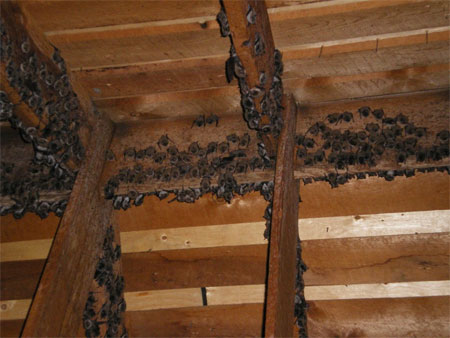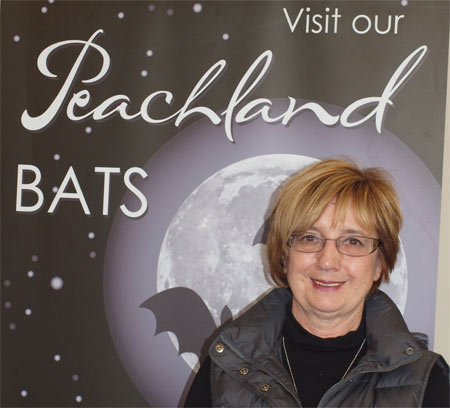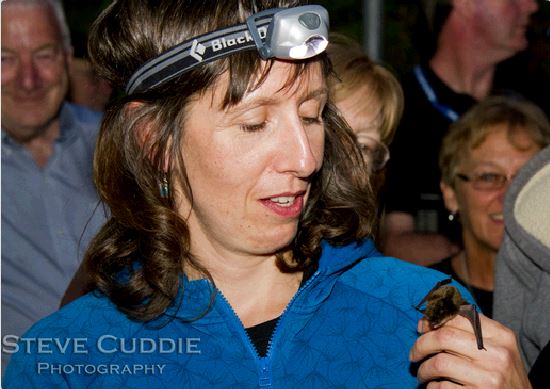What was first thought to be a liability has turned into a biological treasure in Peachland, where one of the largest known maternity colonies of Yuma bats in B.C. has been welcomed—instead of being destroyed.
Located in the attic of a 108-year-old building which was originally the community’s primary school, the bat roost, where as many as 2,000 bats give birth to their pups and raise those young each spring, is now home also to the community’s Chamber of Commerce, tourism centre and the Boys and Girls Club. Those humans share the main floor of the lakefront building, which has undergone extensive renovations, while the maternity colony of bats roost upstairs during the day, swooping one-by-one through the dormers each evening to forage for insects.

Biologist Tanya Luszcz says it’s estimated that this number of bats can consume half to one-and-a-half tonnes of insects in a summer, including many species that are human and agriculture pests. They contribute immensely to the community’s insect control efforts, but are often taken for granted.
The tiny mammals have likely made the attic their maternity roost for decades, but the size of the colony came to light when the community began discussing whether to tear down the building or re-use it—at considerable expense in restoration work. At the time, local resident Darlene Hartford worked for the Chamber of Commerce, which realized the old schoolhouse should be preserved not only for its historic value, but also to protect the bats’ roosting place.
“The first thought was how to get rid of the bats, but then we realized we had a treasure; an opportunity to clear up some of the myths about bats. We realized conservation of the bat colony was not a liability. People love to watch them fly out of the dormers at dusk to hunt over the lake,” she explained.
In 2011, the project to create a first-class demonstration site for bat conservation in human habitats was approved for funding by the Habitat Conservation Trust Foundation’s Public Conservation Assistance Fund, which provides small grants to organizations and individuals with a conservation project in need of some financial help.
“The community bought right into it,” recalled Hartford.
Since then, she has been instrumental in organizing educational programs for young and old, Peachland residents and visitors alike. The programs are centred around the intriguing life of bats, and include videos, live cameras in the roost and events where a biologist talks about their habits.
 Today, Hartford volunteers for the bat project, conducting Bat Chats all summer for the public and networking with other chambers and at events to raise awareness of the project. As well, she conducts school tours, for which there is a charge to try and recoup some of the expenses involved in monitoring the colony and maintaining the roost.
Today, Hartford volunteers for the bat project, conducting Bat Chats all summer for the public and networking with other chambers and at events to raise awareness of the project. As well, she conducts school tours, for which there is a charge to try and recoup some of the expenses involved in monitoring the colony and maintaining the roost.
Despite her wide-ranging knowledge about bats now, Hartford notes, “I didn’t know anything about bats when we began, although I was always environmentally aware.”
The first bats begin returning to the roost in late March and early April each year, bearing live young that are about the size of a thumbnail, in June. When their young are tiny, the adults go out at night to feed, leaving all the pups in one spot in the attic where a ‘babysitter’ may be left behind to tend to them. The mothers leave to feed for three or four hours before returning to nurse their young, explains Hartford.
“Amazingly, the mother bat is able to find her own pup from among hundreds of others,” noted Luszcz.
Three to six weeks later, the pups are able to fly and can forage for insects alongside their mothers, she explained.
Along with public education and a draw to Peachland for visitors, the bat project has led to scientific research into different facets of bat behaviour, from over-wintering habits and acoustic studies to population monitoring.
“We know very little about where our bats go in winter, so it is important to determine this information to help in their conservation.
“In general, roost sites are thought to be more limited for bats than food, so the Peachland schoolhouse is a very valuable resource for bats. That said, food availability may be increasingly compromised in our managed landscape.”







